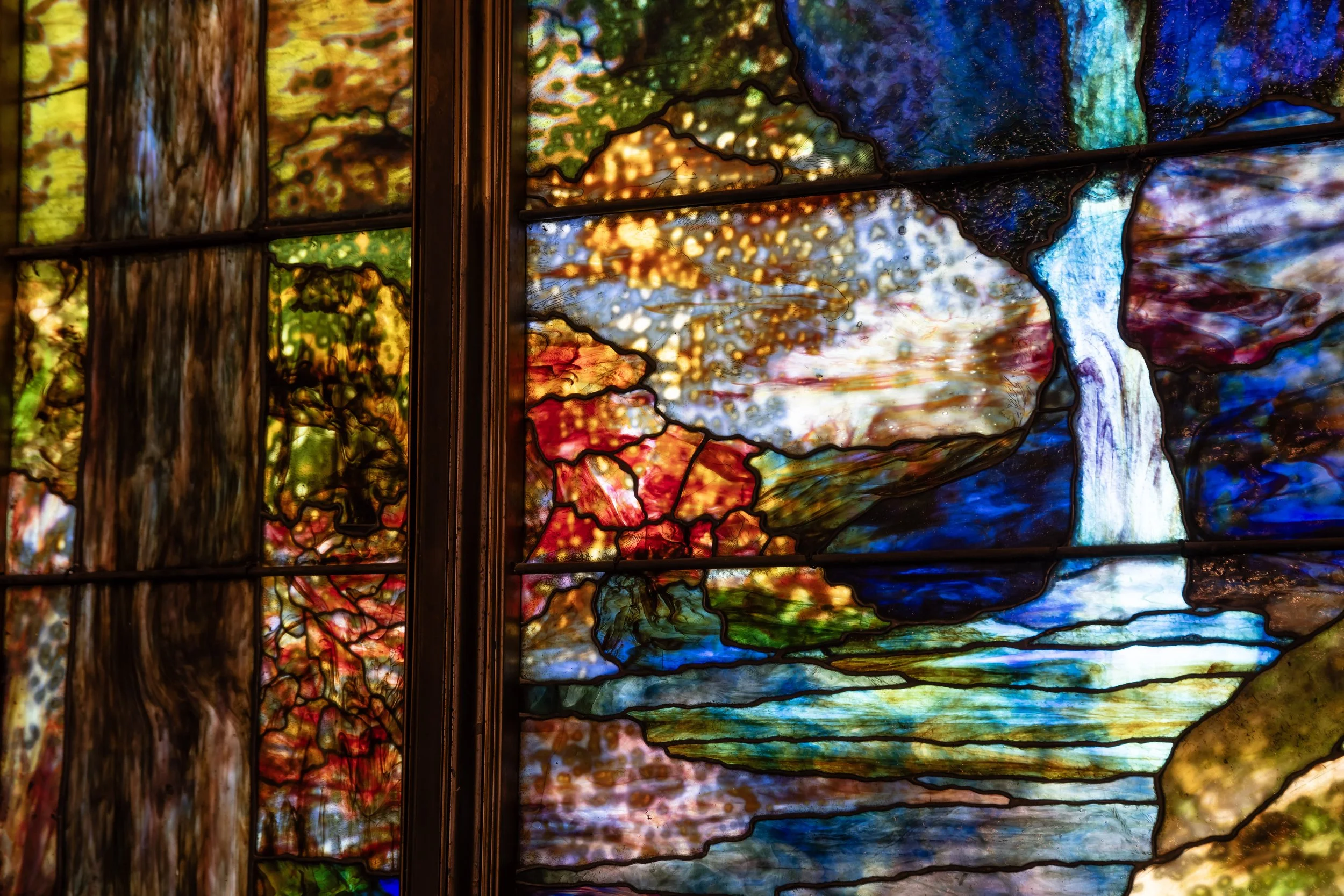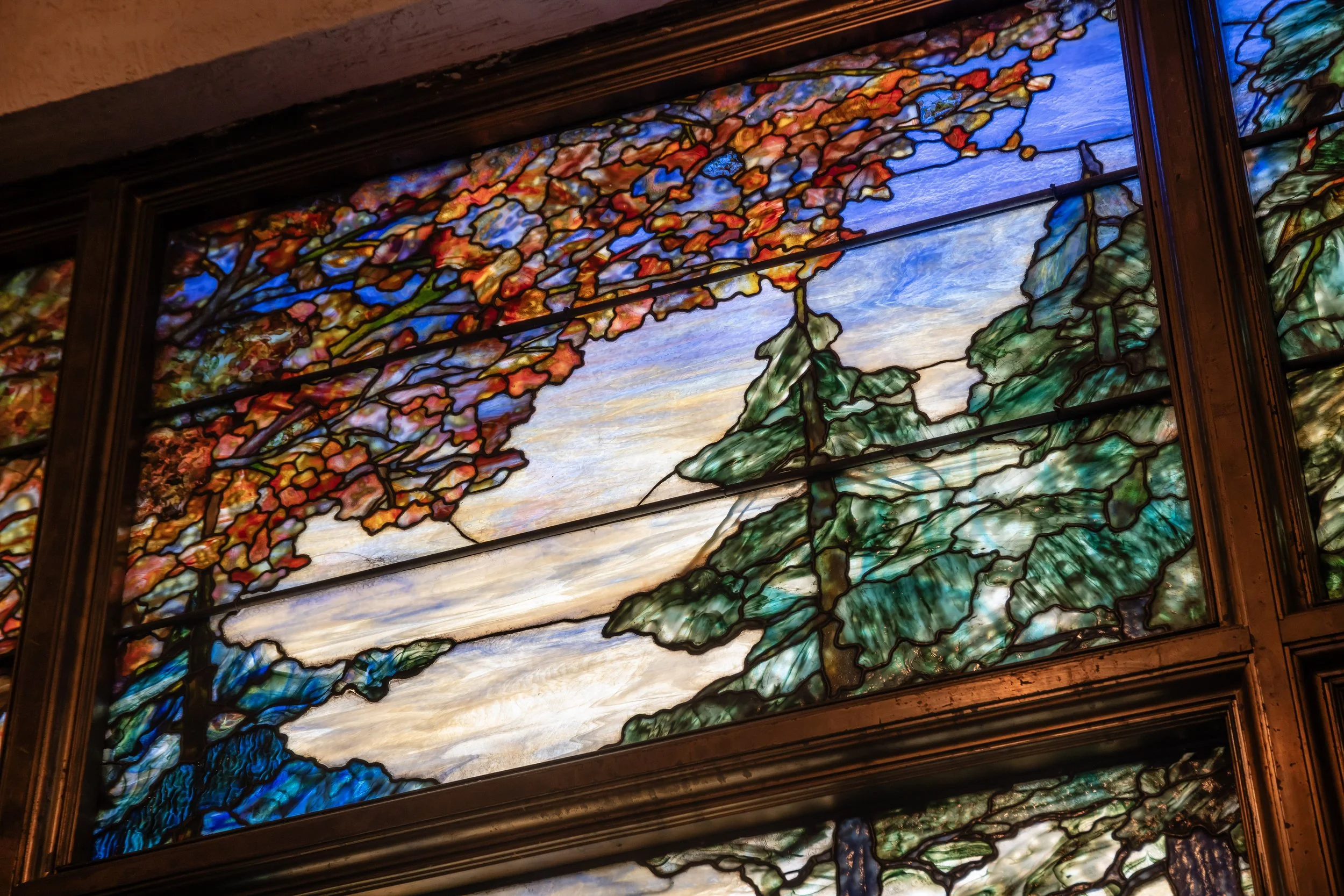Conserving a Tiffany Window: Interview with Ariana Makau by ARTnews
Mountain Landscape (Root Memorial Window), created by Tiffany Studios in 1917. Installation view: Sunset Ridge Church of Christ, San Antonio, Texas. Photo courtesy of Ansen Seale.
Mountain Landscape (Root Memorial Window), created by Tiffany Studios in 1917. Installation view: Sunset Ridge Church of Christ, San Antonio, Texas. Photo courtesy of Ansen Seale.
Detail of Mountain Landscape (Root Memorial Window), created by Tiffany Studios in 1917. Installation view: Sunset Ridge Church of Christ, San Antonio, Texas. Photo courtesy of Ansen Seale.
Detail of Mountain Landscape (Root Memorial Window), created by Tiffany Studios in 1917. Installation view: Sunset Ridge Church of Christ, San Antonio, Texas. Photo courtesy of Ansen Seale.
The following post includes excerpts from this article by Maximilíano Durón in ARTnews, May 21, 2025.
Crystal Bridges Museum of American Art has acquired Mountain Landscape (Root Memorial Window), a monumental stained-glass masterpiece created by Tiffany Studios in 1917. The historic window will be relocated from a San Antonio, Texas, church and undergo a careful conservation process prior to arriving at the museum. It will be displayed as a key element in the museum’s fully reimagined collection presentation, driven by a major building and campus expansion, opening in 2026.
Measuring 110 x 93 inches, this significant addition to the museum’s growing collection of American craft shows Louis Comfort Tiffany’s signature effects of vibrantly colored glass to depict a cascading waterfall framed by lush foliage. Activated by changes in natural light over the course of the day, the window’s subtle shifts of color evoke the spiritual experience of a wooded landscape. The window’s design, like several from this era, is attributed to Agnes F. Northrop, who served as lead designer and worked for Tiffany Studio for half a century.
Crystal Bridges has acquired the work from Sunset Ridge Church and Collective in San Antonio, Texas, where the window cast its glow in the chapel for 94 years. In a joint initiative to preserve the window for future generations and ensure it continues to inspire the public, Crystal Bridges and Sunset Ridge have collaborated closely on the project of relocating the work to the museum, reflecting the dedication of both institutions to stewardship, accessibility, and community storytelling.
Crystal Bridges will embark on a meticulous conservation process before unveiling the window to the public in Bentonville, ensuring that this historic piece is preserved for future generations. The process is grounded in collaboration, drawing on the expertise of multiple contributors. Bryant J. Stanton and his team at Stanton Studios in Waco, Texas, led the process of removing the window from its architectural setting. Ariana Makau, founder and principal conservator of Nzilani Glass Conservation, joined for the removal and will lead the extensive assessment, cleaning, and conservation of the work with her Oakland, California-based team.
Conserving the Window
What distinguishes Tiffany Studios work in stained glass is that the color is infused directly into multiple levels of glasses, which at times can number to four or five layers, as opposed to the more traditional European style, in which the glass is hand-painted, or stained glass windows that have just one pane of glass. Similarly, the Root Memorial Window also uses a variety of stained-glass techniques that distinguish it as a work by Tiffany Studios, including a confetti technique in which small shards of differently colored glass are sprinkled over the base layer of glass. These techniques add to the sense of the depth in the scene.
“The fact that there’s absolutely no paint on this glass—all the depth, the color, and figurative references are created only by glass—speaks to the innovation of the American Arts and Crafts movement,” stained glass conservator Ariana Makau, who is leading the window’s conservation, told ARTnews.
To further illustrate the innovation in the Root Memorial Window, Padgett pointed to the mountain peak that can be seen in the center of the composition. “The edges of the mountains are not in the front pane of the glass, they’re in a pane that’s further to the back, so when we see the ridges of the mountain, it feels like atmospheric perspective. It has this kind of hazy view into the distance.”
These approaches allow for a higher saturation of color and depth of texture and perspective—but they also complicate the work’s conservation.
After the window was deinstalled earlier this month, it was sent to Makau’s Nzilani Glass Conversation studio in Oakland, California, where it has gone through a thorough analysis, including documentation and notations about its condition and the various passages that might need restoration. That work will wrap in the coming days and then its conservation, which will likely take several months, will begin.
“One of the challenges—and one of the most amazing things—about Tiffany Windows is that they’re plated,” Makau said. “Most leaded art glass windows have one piece of glass that’s the same from the front and the back. But, with Tiffany, on the front, it seems relatively flat, and then on the back, it looks like a topographic map.”
The main focus of the conversation project is to clean layers of dirt from the glass, acquired over years of exposure to both the wind, sun, trees, and possibly smoke from candles in the chapel nearby, as well as horizontal water-mark lines that indicate a possible “water egress that came in between the plating for a little bit, and then evaporated over time because it’s so hot in Texas,” according to Makau. Additionally, any cracks will be repaired by being filled in with a museum-grade epoxy, which can be mixed with color, that that has the same refractive index as glass, or “reflects light the same way glass does,” she said.
Despite its age and exposure, the window is relatively stable and does not need to be taken apart and re-leaded to be restored to its original colorations. Because the Root Memorial Window will be displayed in a temperature-controlled gallery at Crystal Bridges and not exposed to the elements, Makau said that it will not need to add additional protective layers to the window, as it has for Tiffany Windows that have been reinstalled in homes.
“In this case, I think we’re going to reveal a lot of the vibrancy that was lost over time,” Makau said. “Every single piece was so thoughtfully chosen and placed.”
To read the full article by ARTnews, click here.
To watch a short video about the project, click here.




